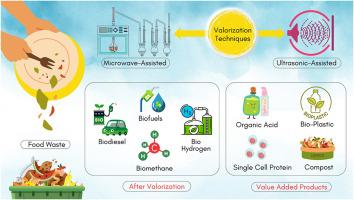微波和超声辅助水解食物垃圾转化为生物能源和增值产品的最新进展和趋势-一种可持续的方法
IF 5.8
2区 生物学
Q1 AGRICULTURAL ENGINEERING
引用次数: 0
摘要
食物浪费的规模令人震惊(全球为13亿吨),造成了8 - 10%的温室气体排放,因此需要采取可持续的定价方法。在先进的技术中,微波辅助水解或超声波辅助水解成为将生物质转化为有价值产品的极其有效的策略。这些技术使用微波诱导的介质加热和超声波驱动的空化来改善细胞壁破坏、传质和水解效率,在反应时间、产率和能耗方面远远超过传统的水解方法。超声波和微波辅助水解技术的最新进展表明,在黄酮类化合物、类胡萝卜素和多酚的生产或提取方面具有巨大的潜力。这篇综述批判性地评估了目前的突破,机理见解,优化方法,以及微波辅助水解或超声波辅助水解在食物垃圾增值中的相对功效。此外,新的混合方法,如超声-微波协同水解,正在研究其提高工艺效率和工业可扩展性的潜力。采用综合增值法,氢气转化率高达58.4%,可合成2.49倍的挥发性脂肪酸。生命周期分析已在一些工程中报道,微波辅助提取可节省5.82%的能源需求。未来的努力应集中在开发无溶剂和酶辅助系统,并促进基于生物精炼厂的循环经济模式,以综合食物垃圾增值。通过填补知识空白和确定研究重点,这项工作为下一代可持续的废物转化为价值解决方案奠定了基础,为零废物生物处理和有弹性的全球粮食系统铺平了道路。本文章由计算机程序翻译,如有差异,请以英文原文为准。

Recent advances and trends in food waste valorization via microwave and ultrasonic-assisted hydrolysis into bio-energy and value-added products-A sustainable approach
The alarming scale of food waste (1.3 billion tonnes globally), contributing 8–10 % greenhouse gas emissions, necessitates sustainable valorization approaches. Among advanced technologies, microwave-assisted hydrolysis or ultrasonic-assisted hydrolysis emerged as extremely effective strategies for biomass conversion into valuable products. These techniques use microwave-induced dielectric heating and ultrasound-driven cavitation to improve cell wall disruption, mass transfer, and hydrolytic efficiency, far surpassing traditional hydrolysis procedures in terms of reaction time, yield, and energy consumption. Recent developments in ultrasonic and microwave assisted hydrolysis have demonstrated a great potential in terms of the production or extraction of flavonoids, carotenoids, and polyphenols. This review critically evaluates current breakthroughs, mechanistic insights, optimization methodologies, and the relative efficacy of microwave-assisted hydrolysis or ultrasonic-assisted hydrolysis in food waste valorization. Furthermore, new hybrid approaches, such as ultrasound-microwave synergistic hydrolysis, are being investigated for their potential to improve process efficiency and industrial scalability. Using integrated valorization high 58.4 % hydrogen conversion efficiency has been reported, along with 2.49-fold volatile fatty acid synthesis. The life cycle analysis has been reported in some works where in microwave assisted extraction could save 5.82 % energy demand. Future efforts should concentrate on developing solvent-free and enzymatically assisted systems and promoting bio refinery-based circular economy models for integrated food waste valorization. By filling knowledge gaps and establishing research priorities, this effort provides the groundwork for the next generation of sustainable waste-to-value solutions, paving the way for zero-waste bioprocessing and a resilient global food system.
求助全文
通过发布文献求助,成功后即可免费获取论文全文。
去求助
来源期刊

Biomass & Bioenergy
工程技术-能源与燃料
CiteScore
11.50
自引率
3.30%
发文量
258
审稿时长
60 days
期刊介绍:
Biomass & Bioenergy is an international journal publishing original research papers and short communications, review articles and case studies on biological resources, chemical and biological processes, and biomass products for new renewable sources of energy and materials.
The scope of the journal extends to the environmental, management and economic aspects of biomass and bioenergy.
Key areas covered by the journal:
• Biomass: sources, energy crop production processes, genetic improvements, composition. Please note that research on these biomass subjects must be linked directly to bioenergy generation.
• Biological Residues: residues/rests from agricultural production, forestry and plantations (palm, sugar etc), processing industries, and municipal sources (MSW). Papers on the use of biomass residues through innovative processes/technological novelty and/or consideration of feedstock/system sustainability (or unsustainability) are welcomed. However waste treatment processes and pollution control or mitigation which are only tangentially related to bioenergy are not in the scope of the journal, as they are more suited to publications in the environmental arena. Papers that describe conventional waste streams (ie well described in existing literature) that do not empirically address ''new'' added value from the process are not suitable for submission to the journal.
• Bioenergy Processes: fermentations, thermochemical conversions, liquid and gaseous fuels, and petrochemical substitutes
• Bioenergy Utilization: direct combustion, gasification, electricity production, chemical processes, and by-product remediation
• Biomass and the Environment: carbon cycle, the net energy efficiency of bioenergy systems, assessment of sustainability, and biodiversity issues.
 求助内容:
求助内容: 应助结果提醒方式:
应助结果提醒方式:


